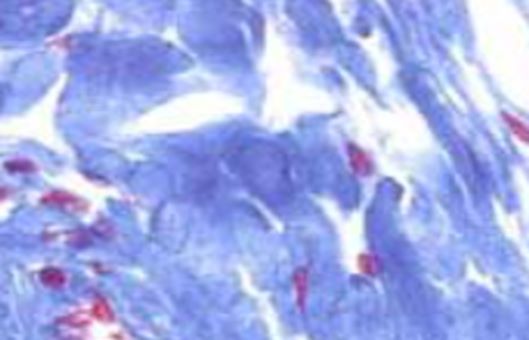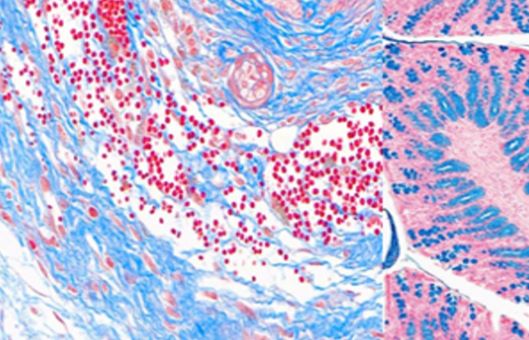DAPI Counterstaining Protocol
GUIDELINE
DAPI is a popular nuclear counterstain for use in multicolor fluorescent techniques. Its blue fluorescence stands out in vivid contrast to green, yellow, or red fluorescent probes of other structures. When used according to our protocols, DAPI stains nuclei specifically, with little or no cytoplasmic labeling. Both DAPI and DAPI dilactate work well in these protocols. The DAPI dilactate form may be somewhat more water-soluble. The counterstaining protocols are compatible with a wide range of cytological labeling techniques—direct or indirect antibody-based detection methods, mRNA in situ hybridization, or staining with fluorescent reagents specific to cellular structures. DAPI can also serve to fluorescently label cells for analysis in multicolor flow cytometry experiments. The following protocols can be modified for tissue staining or for staining unfixed cells or tissues.
METHODS
Counterstaining protocol of adherent cells for fluorescence microscopy
- Equilibrate the sample briefly with phosphate-buffered saline (PBS).
- Dilute the DAPI stock solution to 300 nM in PBS. Add approximately 300 µL of this dilute DAPI staining solution to the coverslip preparation, making certain that the cells are completely covered.
- Incubate for 1-5 minutes.
- Rinse the sample several times in PBS. Drain excess buffer from the coverslip and mount. We recommend using a mounting medium with antifade reagents.
- View the sample using a fluorescence microscope with appropriate filters.
Counterstaining protocol of cells in suspension for flow cytometry
- Dilute the DAPI stock solution to 3 µM in staining buffer (100 mM Tris, pH 7.4, 150 mM NaCl, 1 mM CaCl2, 0.5 mM MgCl2, 0.1% Nonidet P-40). A 1 mL volume will be required for each cell sample.
- Centrifuge the cell suspension and discard the supernatant. Tap to loosen the pellet and add 1 mL of DAPI diluted in staining buffer.
- Incubate for 15 minutes at room temperature.
- Analyze by flow cytometry in the presence of the dye. If the cells are to be viewed by fluorescence microscopy, centrifuge the sample, remove the supernatant, and resuspend the cells in a fresh buffer. Apply a drop of the suspension to a microscope slide, cover it with a coverslip, and view.
Counterstaining protocol for Chromosome FISH
- Dilute the DAPI stock solution to 30 nM in PBS. Pipet 300 µL of this staining solution directly onto the specimen. A plastic coverslip can be used to distribute the dye evenly on the slide.
- Incubate the specimen in the dark for 30 minutes at room temperature.
- Carefully remove the coverslip and rinse the specimen briefly with PBS or dH2O to remove unbound dye.
- Remove excess liquid from the slide by gently blotting around the sample with an absorbent tissue.
- Place a glass coverslip on the slide and seal the edges with wax or nail polish. Alternatively, the preparation can be mounted in an antifade reagent according to the manufacturer's directions.
- View the sample using a fluorescence microscope with appropriate filters.
Creative Bioarray Relevant Recommendations
Creative Bioarray offers a variety of fluorescent dyes and special dyes to help you better understand molecular biology. We also offer a variety of comprehensive and reliable special staining for sectioned paraffin-embedded tissues or cells to fit all individual needs.
NOTES
- Determine the appropriate concentration of DAPI in the mounting medium or staining solution and the optimal incubation time to achieve specific and bright nuclear staining without excessive background. Typically, DAPI is used at a concentration of 0.1-1 μg/ml, and the incubation time is kept short (e.g., 5-15 minutes) to minimize non-specific staining.
- In some cases, especially for fixed and permeabilized cells, proper permeabilization methods should be adopted to allow DAPI to penetrate the cell membranes and stain the nuclei uniformly.
- Determine the appropriate excitation and emission wavelengths for DAPI fluorescence, as well as the optimal microscopy settings for imaging DAPI-stained nuclei. Pay attention to exposure times and image acquisition conditions to avoid bleaching or saturation of the signal.

